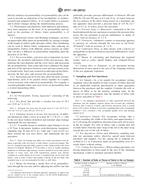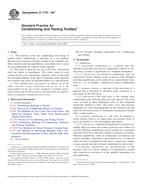Potřebujeme váš souhlas k využití jednotlivých dat, aby se vám mimo jiné mohly ukazovat informace týkající se vašich zájmů. Souhlas udělíte kliknutím na tlačítko „OK“.
ASTM D737-04(2012)
Standard Test Method for Air Permeability of Textile Fabrics
Automaticky přeložený název:
Standardní zkušební metoda pro prodyšnost textilie
NORMA vydána dne 1.7.2012
Informace o normě:
Označení normy: ASTM D737-04(2012)
Poznámka: NEPLATNÁ
Datum vydání normy: 1.7.2012
Kód zboží: NS-38295
Počet stran: 5
Přibližná hmotnost: 15 g (0.03 liber)
Země: Americká technická norma
Kategorie: Technické normy ASTM
Kategorie - podobné normy:
Anotace textu normy ASTM D737-04(2012) :
Keywords:
air permeability, fabric, ICS Number Code 59.080.30 (Textile fabrics)
Doplňující informace
| Significance and Use | ||||||||||||
|
This test method is considered satisfactory for acceptance testing of commercial shipments since current estimates of between-laboratory precision are acceptable, and this test method is used extensively in the trade for acceptance testing. If there are differences of practical significance between reported test results for two laboratories (or more), comparative tests should be performed to determine if there is a statistical bias between them, using competent statistical assistance. As a minimum, ensure the test samples to be used are as homogeneous as possible, are drawn from the material from which the disparate test results were obtained, and are randomly assigned in equal number to each laboratory for testing. The test results from the two laboratories should be compared using a statistical test for unpaired data, at a probability level chosen prior to the testing series. If bias is found, either its cause must be found and corrected, or future test results for that material must be adjusted in consideration of the known bias. Air permeability is an important factor in the performance of such textile materials as gas filters, fabrics for air bags, clothing, mosquito netting, parachutes, sails, tentage, and vacuum cleaners. In filtration, for example, efficiency is directly related to air permeability. Air permeability also can be used to provide an indication of the breathability of weather-resistant and rainproof fabrics, or of coated fabrics in general, and to detect changes during the manufacturing process. Performance specifications, both industrial and military, have been prepared on the basis of air permeability and are used in the purchase of fabrics where permeability is of interest. Construction factors and finishing techniques can have an appreciable effect upon air permeability by causing a change in the length of airflow paths through a fabric. Hot calendaring can be used to flatten fabric components, thus reducing air permeability. Fabrics with different surface textures on either side can have a different air permeability depending upon the direction of air flow. For woven fabric, yarn twist also is important. As twist increases, the circularity and density of the yarn increases, thus reducing the yarn diameter and the cover factor and increasing the air permeability. Yarn crimp and weave influence the shape and area of the interstices between yarns and may permit yarns to extend easily. Such yarn extension would open up the fabric, increase the free area, and increase the air permeability. Increasing yarn twist also may allow the more circular, high-density yarns to be packed closely together in a tightly woven structure with reduced air permeability. For example, a worsted gabardine fabric may have lower air permeability than a woolen hopsacking fabric. |
||||||||||||
| 1. Scope | ||||||||||||
|
1.1 This test method covers the measurement of the air permeability of textile fabrics. 1.2 This test method applies to most fabrics including woven fabrics, nonwoven fabrics, air bag fabrics, blankets, napped fabrics, knitted fabrics, layered fabrics, and pile fabrics. The fabrics may be untreated, heavily sized, coated, resin-treated, or otherwise treated. 1.3 The values stated in SI units are to be regarded as the standard. The values stated in inch-pound units may be approximate. 1.4 This standard does not purport to address all of the safety concerns, if any, associated with its use. It is the responsibility of the user of this standard to establish appropriate safety and health practices and determine the applicability of regulatory limitations prior to use. |
||||||||||||
| 2. Referenced Documents | ||||||||||||
|
Podobné normy:
Historická
15.7.2010
Historická
1.7.2014
Historická
1.7.2013
Historická
1.7.2014
Historická
1.7.2011
Historická
1.8.2008
Odebírejte informace o nově vydaných normách ZDARMA:
Chcete pravidelně odebírat informace o nově vycházejících normách z celého světa a to zcela zdarma?
Přihlašte se k odběru. Vše je velice jednoduché a absolutně ZDARMA.
Na výběr máte vydavatele z celého světa.



 ASTM D1230-10
ASTM D1230-10 ASTM D1388-14
ASTM D1388-14 ASTM D1424-09(2013)..
ASTM D1424-09(2013).. ASTM D1518-14
ASTM D1518-14 ASTM D1683/D1683M-11..
ASTM D1683/D1683M-11.. ASTM D1776-08e1
ASTM D1776-08e1
 Cookies
Cookies
